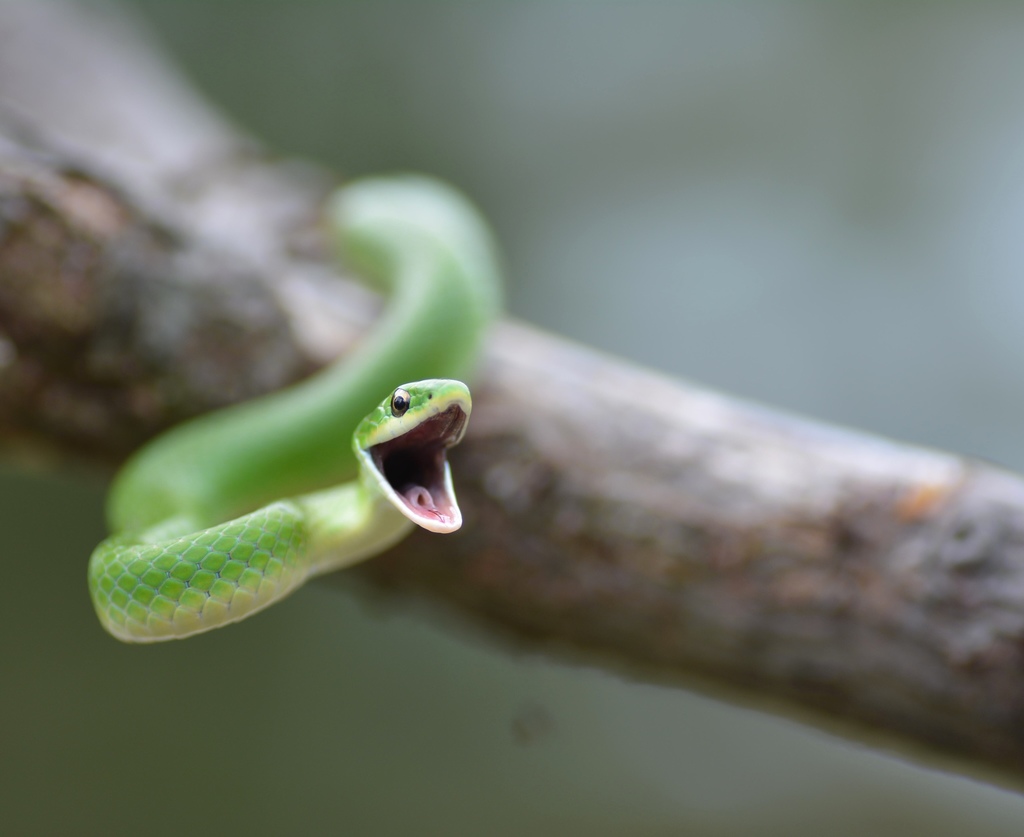
Rough and smooth green snakes are closely related, and while there are some differences between them, their care in captivity is essentially the same. These are both small, thin-bodied snakes that are native to North America, where their numbers are becoming threatened or endangered in many states. Both species are a bright emerald-green in color with a pale yellow or cream-colored belly; they are reported to take on a bluish tone when excited. In the pet trade, rough green snakes are seen more commonly than smooth green snakes, but both make good "look only" pets for the experienced reptile keeper. Since they are shy feeders and prefer quiet habitats, they are not the best match for a first-time snake keeper or for environments with young children.
HOUSING THE GREEN SNAKE
Green snakes are small snakes, so while you don't need a huge tank, you do need to provide vertical space for climbing. As green snakes are peaceful, they can also be kept in groups—three can live comfortably in a 30-gallon enclosure.
A 30-gallon hexagonal tank is a good choice because it provides lots of space for greenery as well as hiding spots. Since rough and smooth green snakes both have thin bodies, an escape-proof enclosure is a must. The tank will need a very tight-fitting fine mesh screen lid to prevent escapes. Clamped-down lids work best
Green snakes that do not have lots of greenery to hide amongst will become stressed. These snakes are small enough that live plants such as pothos, ivy, and other nontoxic plants will do fine in the tank, and even silk plants will work in a pinch. The greenery should fill at least 50 percent of the tank. Branches and vines should also be provided for climbing. Also, include some hide boxes.
HEAT
An overhead heat source such as a heat bulb (white light during the day and red or blue/purple at night) or ceramic heat emitter is best. The overhead heat source can be supplemented by heat from an under tank heat mat, but make sure your snake cannot sit directly on the heated glass, because thermal burns may follow.
A suggested temperature gradient for green snakes is 70 to 80 F (21 to 27 C), though some references suggest a higher range. At night, the temperature can be allowed to drop to between 65 and 75 F (18 to 24 C).
LIGHT
Being diurnal (day dwellers), these snakes should also have a UVA/UVB bulb on for 10 to 12 hours per day. Any visible light and any UVB light source should be turned off at night to give the snake a light-dark cycle.
Assuming your snake will not have access to bright sunlight, ZooMed's reptile or iguana lights, and Durotest's Vita-Lite are two good products. Replace the UVB light sources every six months.
HUMIDITY
This species does not require high humidity. In addition to some occasional misting, the snake's water dish will add to the humidity in the tank which should be maintained at roughly 40 to 50 percent. Use a hygrometer to measure interior levels, and monitor closely during dry winter months if you are keeping your snake in a colder climate. A temporary increase of up to 60 percent humidity will assist any snake during its shedding process.
SUBSTRATE
Materials that line the bottom of the enclosure (the substrate) should be carefully selected for both safety to green snakes and ease of cleaning. For these arboreal snakes, reptile carpet makes a good choice, as do simple paper towels or inkless newspaper. Substrate materials that could accidentally be ingested are best avoided.
FOOD & WATER
Green snakes are insectivores and are among the few snakes that eat a diet consisting entirely of insects and worms. In the wild, they consume a variety of prey such as crickets, moths, grasshoppers, caterpillars, fly larvae, spiders, and worms.
In captivity, feed a diet consisting mainly of soft-bodied prey such as caterpillars, although it is extremely important to make sure the diet is still varied. As much as possible, add in items such as pesticide-free spiders, moths, flies, and their larvae.
Mealworms, grasshoppers, and crickets can be fed to green snakes but only occasionally, as any insects with tough exoskeletons may pose a risk of impaction if eaten too often. Pick only the freshly molted mealworms to reduce the chances. Other soft feeder worms, such as wax worms, could also be offered on occasion. Be sure that you don't offer any prey items that are wider than your snake's body.
All prey items should be gut-loaded, meaning that they have been fed a nutritious diet themselves—including a vitamin and mineral supplement—before being offered to green snakes. Prey items should also be dusted with a calcium supplement a few times a week.
Feed your green snakes a few times on feeding day, totaling what they will eat over a 20-minute period. But feeding days should be only once or twice per week. Feeding at dawn or dusk will bring out a snake that is most willing to eat, but if your snake still is uninterested in food, try moving the enclosure to a more quiet room where there is less activity.
Like the arboreal lizards, these snakes prefer drinking water droplets off of leaves rather than from a bowl or other groundwater source, so a daily misting of the greenery is required. However, it is still important to provide a shallow dish of water that is large enough for the snake to climb into for a full-body soak, but shallow enough to prevent drowning.